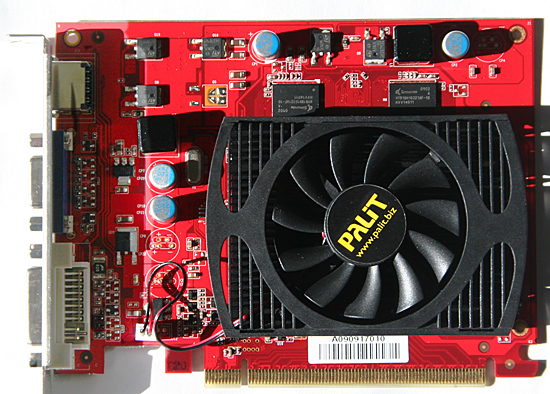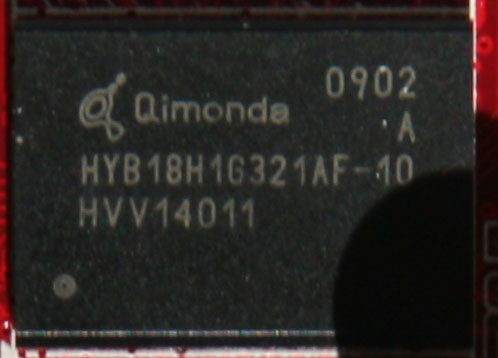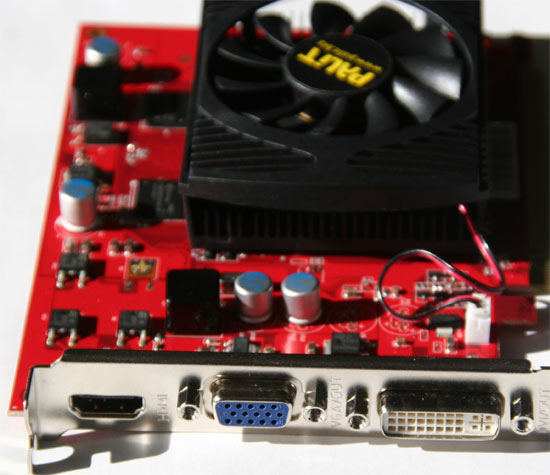NVIDIA’s GeForce GT 220: 40nm and DX10.1 for the Low-End
by Ryan Smith on October 12, 2009 6:00 AM EST- Posted in
- GPUs
Palit’s GT 220 Sonic Edition
As we mentioned in our introduction, for today’s launch we have a GT 220 graciously provided by Palit, in the form of their $79 GT 220 Sonic Edition. This card is ever so slightly factory overclocked, coming in at 650MHz for the core (a 4% overclock), a standard 1360MHz for the shaders, and 900MHz for its GDDR3 memory. As this is a GDDR3 card, it comes with 512MB of RAM.

As far as we know, this is as close to a reference cooler as you’re going to see for the GT 220, as we’ve seen this cooler on a couple other product brochures. It’s a rectangular single-slot height heatsink, with a fan mounted above it. This makes the entirety of the cooler wider than a single slot, and in practice this is a dual-slot card even if it’s not officially classified as such. The fan used is a simple two pin fan, so it blows at a fixed rate.

The 4 memory chips on this card are Qimonda HYB18H1G321AF-10. We haven’t been able to find the precise specs for that specific memory chip, but we believe it’s rated for 1000MHz, 100MHz over the operating speed of the card. We’re somewhat curious where Palit is getting these chips though, since Qimonda ceased production 6 months ago amidst bankruptcy. Apparently there’s a stockpile of these things somewhere.
Since it’s a low-power card, the overall design of the GT 220 Sonic Edition is rather simple compared to the complex beasts we see on the high-end. Nothing except the GT216 core itself is cooled, and we know that Palit is using solid OS-CON capacitors.

The port layout for this card is 1 HDMI port, 1 VGA port, and 1 DVI port, which appears to be the standard for the GT 220. With one of each port type, Palit’s GT220 Sonic Edition does not come with any port dongles. For that matter, the only other thing you’ll find in the box is a basic manual and driver CD (190.45).
| Form Factor | GT 220 Sonic 512MB | GT 220 1GB DDR3 | GT 220 1GB DDR2 | GT 220 512MB DDR2 |
| Stream Processors | 48 | 48 | 48 | 48 |
| Texture Address / Filtering | 16 / 16 | 16 / 16 | 16 / 16 | 16 / 16 |
| ROPs | 8 | 8 | 8 | 8 |
| Core Clock | 650MHz | 635MHz | 635MHz | 635MHz |
| Shader Clock | 1360MHz | 1360MHz | 1360MHz | 1360MHz |
| Memory Clock | 900MHz | 790MHz | 400MHz |
400MHz |
| Memory Bus Width | 128-bit | 128-bit | 128-bit | 128-bit |
| Frame Buffer | 512MB | 1GB | 1GB | 512MB |
| Transistor Count | 486M | 486M | 486M | 486M |
| Manufacturing Process | TSMC 40nm | TSMC 40nm | TSMC 40nm | TSMC 40nm |
| Price Point | $79 | ? | ? | ? |
Palit will be releasing three other GT 220 cards, in the other configurations that NVIDIA is allowing. These will be two DDR2-equiped cards with 512MB or 1GB of memory running at 400MHz, and a 1GB DDR3 card with its memory running at 790MHz. We don’t have these other cards on-hand, but based on the performance data supplied by Palit, the DDR3 card should be within 10% of the Sonic Edition, and the DDR2 card will be around 60% the speed.
Finally, Palit’s cards should be available from Newegg starting on Tuesday. Palit retreated from the North American market earlier this year to reorganize, so this marks the resumption of their North American retail sales.










80 Comments
View All Comments
chizow - Monday, October 12, 2009 - link
Is this the one you're referring to Ryan?http://www.newegg.com/Product/Product.aspx?Item=N8...">http://www.newegg.com/Product/Product.a...E1681412...
From all reports and feedback I've seen, that Asus part is 96SP for $40 AR (was actually $35 at one point!) just as Ben stated.
I don't really care about this segment of parts for actual 3D so you may be right. I was only interested in that Asus 96SP because it was identified by many users as "the card" to get for dedicated PhysX on a budget. I was hoping to find a low-power consumption candidate on 40nm for dedicated PhysX, but it seems these parts have too few SP to be viable.
BenSkywalker - Monday, October 12, 2009 - link
Why not include benches of the nV part that you quoted the price for then(btw- NewEgg is also listing one of the 384MB 96SP 9600GSOs for $56.49)?It is rather misleading to put it mildly that you decide to include benches for one part that is quite a bit cheaper, and quite a bit slower, and then quote the price on the next rung up on the performance ladder. It would be akin to showing benches for the GTX275 and lamenting it because the GTX285 was so expensive, it doesn't make any sense.
Ryan Smith - Monday, October 12, 2009 - link
Which part? The 9600GT, or the 48SP GSO?What you see are all of the low-end cards we were able to get our hands on for this article.
jordanclock - Monday, October 12, 2009 - link
The graphs on the "Temperature and Noise" page are high-to-low. Usually they're the opposite, following the idea that lower numbers are better. I know, I know, it's a lame nitpick.As for the card: If they added this checkbox feature for OEMs (which I believe) then why bother allowing for retail distribution? This card really doesn't bring anything that isn't already done with cards they already have available. Seems like a rather silly release.
Ryan Smith - Monday, October 12, 2009 - link
Fixed. Thanks.jonup - Monday, October 12, 2009 - link
Ryan, the Palit table shows their 1GB card's frame buffer as 512MB.strikeback03 - Monday, October 12, 2009 - link
Seems recently there have been a lot of low-end cards with 1GB of memory onboard. Is this just a marketing ploy, or is there actually some scenario where it would be useful to have lots of memory but not much processing power?Concillian - Monday, October 12, 2009 - link
The 1GB on low end cards is a marketing thing. The "average consumer" equates more memory with performance and generally have little to no knowledge about the importance of GPU type, speed, or graphics memory bandwidth.nVidia and ATi have been taking advantage of this to help add profit margin since at least the GeForce 4 MX generation.
Zingam - Monday, October 12, 2009 - link
This will be one craptastic graphics card for the masses! Yay!Good luck, NVIDIA!
Dante80 - Monday, October 12, 2009 - link
This could have been a killer HTPC card...one year ago.I understand the need for nvidia to come up with sth for this market segment, and I like very much both the improved audio and the low power consumption.
But lets be honest here. This card has no place in the current retail market. It merely looks as a project to max margins for OEM use. OEMs can market a "Brand new card with a smaller process, DX10.1 support and 1 whole GB of memory goodness", but retail vendors and nvidia will have a hard time convincing anyone to buy this instead of going for a 9600 or a 4670.
Since margins seem godly, nvidia should lower the price and try to saturate the market segment with these cards in a HTPC (suicide) mission. That would at least make sense to consumers.